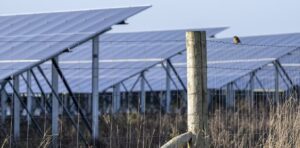The pro-renewable lobby, under attack in Europe and elsewhere for what its critics call unsustainable subsidies, especially in countries with generous government policies such as Germany, Spain and Italy, had something to celebrate. With the tensions flaring in Ukraine and the ever present threat of cut off in Russian gas supplies to European countries that are heavily dependent on it (see map), they could point to the uninterrupted output from renewable resources as proof of their value.
Andrew Garrad, the President of the European Wind Energy Association (EWEA), speaking at their annual conference in early March 2014, suggested that the threat to Europe’s energy security can be neutered by continued investment in the EU’s wind energy sector. Speaking to the choir, namely a receptive audience, he said, “Mr. Putin can, and perhaps will, turn off the tap that supplies Western Europe with oil and gas but even Mr. Putin, bare chested, or fully clothed, cannot turn off the tap that supplies our wind, our free indigenous fuel.”
 Taking a stab at the recent European Commission’s (EC) decision to abandon country-specific renewable targets for 2020 and beyond (see related article on page 8), he added, “It seems, however, that some politicians would rather line Mr. Putin’s pockets than agree to an ambitious target for renewables for 2030.”
Taking a stab at the recent European Commission’s (EC) decision to abandon country-specific renewable targets for 2020 and beyond (see related article on page 8), he added, “It seems, however, that some politicians would rather line Mr. Putin’s pockets than agree to an ambitious target for renewables for 2030.”
Since EWEA was holding its annual event in Barcelona, Spain, Garrad focused on the contribution of wind to Spain’s electricity sector.
“In 2013, 21.1% of Spain’s electricity was produced by the wind,” more than any other resource, he said.
Given that there was virtually no wind generation in Spain as recently as15 years ago, he added, “We should celebrate that enormous success.” He was, however, quick to point out that, “ … but there is no Spanish minister sitting in the audience today.”
How much wind will be installed in 2014? “I understand that number may even be negative. That tells you that energy is political and renewable energy is particularly political and especially sensitive to political changes.
Spain is an extreme example of what’s happened in Europe over the last few years, something that’s happened in other EU countries if not to the same extreme.” Garrad was, of course, referring to the recent backlash and drastic cutbacks in renewable subsidies, not just in Spain but across the whole continent.
People like Mr. Garrad do not get to top of a powerful organization such as EWEA by accident. They, like the politicians they lobby, are good at making a strong case for the industry they represent.
Garrad reminded the audience, “that every one of you, if you live within the EU pays €2 a day to pay for imports of fossil fuel from outside the EU. If you aggregate that, that’s roughly a billion euros every day we are paying for outside fuels. Our industry brings energy independence and huge savings,” he noted.
Mr. Garrad pointed out that the renewable industry had also fallen victim to “short term political opportunism” by virtue of the fact that the natural time horizons for political governance and for energy planning are hopelessly mismatched. As irritating as that may seem to an organization such as EWEA, that is how our democracies operate.
 The impressive growth of renewables in Europe (graph on bottom of page 10) and a number of US states driven largely by generous feed-in tariffs (FiTs) and mandatory renewable portfolio standards (RPS), respectively, is often mentioned by renewable critics to say enough is enough. Wind and solar energy, they argue, are no longer infant technologies worthy of taxpayer subsidies.
The impressive growth of renewables in Europe (graph on bottom of page 10) and a number of US states driven largely by generous feed-in tariffs (FiTs) and mandatory renewable portfolio standards (RPS), respectively, is often mentioned by renewable critics to say enough is enough. Wind and solar energy, they argue, are no longer infant technologies worthy of taxpayer subsidies.
That explains why, on both sides of the Atlantic, the generous support and subsidy schemes are being withdrawn and/or slashed back. US federal wind subsidies already expired and solar investment tax credit (ITC) is expected to drop to 10% from the current 30% by 2017 – and unlikely to get extended given the current political gridlock in Washington.
Yet the debate on whether taxpayers are getting their money’s worth from renewable subsidies is likely to go on. Those who like renewables will no doubt find reasons to continue to support them, and those who don’t are unlikely to change their mind.
Perry Sioshansi is president of Menlo Energy Economics, a consultancy based in San Francisco, CA and editor/publisher of EEnergy Informer, a monthly newsletter with international circulation. He can be reached at [email protected]













